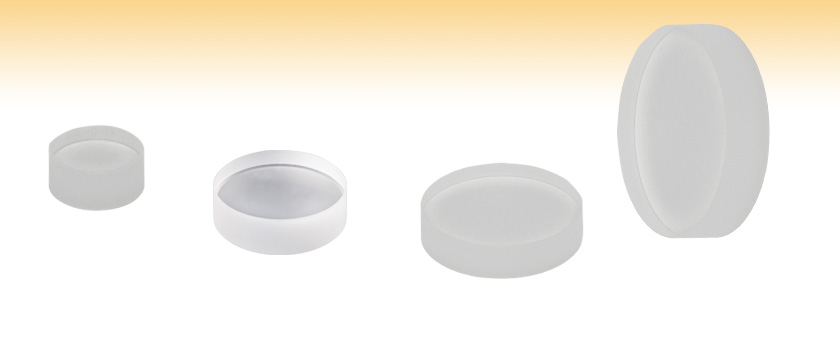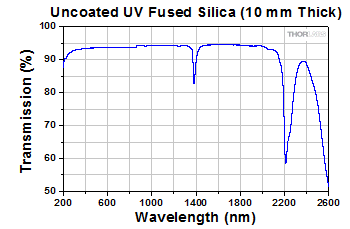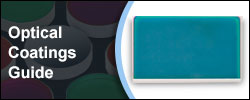溶融石英ミラーブランク

- Front Surface Flatness: <λ/10
- Front Surface Quality: 10-5 Scratch-Dig
- Fabricated from Fused Silica
PF05-03
Ø1/2"
PF07-03
Ø19 mm
PF10-03
Ø1"
PF20-03
Ø2"

Please Wait

Click to Enlarge
このグラフは、厚さ10 mmのコーティング無しUV溶融石英(UVFS)ミラーブランクの垂直入射時の全透過率の測定値です。
特長
- ご用意しているサイズ: Ø12.7 mm(1/2インチ)、Ø19 mm、Ø25.4 mm(Ø1インチ)、Ø50.8 mm(Ø2インチ)
- 前面平坦度:<λ/10(特注でλ/20にも対応可能。詳細は当社までお問い合わせください)
- 裏面: つや消し仕上げ
- 大量注文に対する価格値引きが可能
当社のミラーブランクは、コーティングの際に前面ミラーとして使用できるように設計されています。この製品は溶融石英製で、185 nm~2.1 μmの範囲で高い透過率を有しているので(右の透過率グラフを参照)、高い純度と耐久性を発揮します。
このØ19 mmミラーは、特に、レーザーシステムや他のOEM用にご用意しているPolaris固定式光学マウント用に設計されています。この直径サイズによって、マウントはØ25.4 mm(Ø1インチ)の設置面積を維持しながらØ12.7 mm(Ø1/2インチ)光学素子よりも大きな開口を得ることができます。
| Item # | Diameter | Thickness | Parallelism | Surface Quality | Surface Flatness | Clear Aperture | Material |
|---|---|---|---|---|---|---|---|
| PF05-03 | 12.7 mm +0.0/-0.1 mm | 6.0 mm ± 0.2 mm | <3 arcmin | 10-5 Scratch-Dig | <λ/10 | >90% of Diameter | Fused Silica |
| PF07-03 | 19.0 mm +0.0/-0.1 mm | 6.0 mm ± 0.2 mm | |||||
| PF10-03 | 25.4 mm +0.0/-0.1 mm | 6.0 mm ± 0.2 mm | |||||
| PF20-03 | 50.8 mm +0.0/-0.1 mm | 12.0 mm ± 0.2 mm |
| Posted Comments: | |
ccrocker
(posted 2014-06-12 14:11:01.143) Is it possible to order get these backside polished? jlow
(posted 2014-06-12 02:28:00.0) Response from Jeremy at Thorlabs: Yes we can quote these with the backside polished. I will contact you directly to get more information on the polish quality needed and provide a quote. tor
(posted 2010-11-23 16:12:36.0) Response from Tor at Thorlabs to Andres: While beamsplitters are designed to pass and reflect a specific fraction of light, a reflective ND filter may be more suitable for detector applications. I have contacted you for more information regarding your transmission requirements. andres.aragoneses
(posted 2010-11-23 15:32:40.0) Dear sir/madam
I would like to know if you provide half transparent mirrors, or if that is just beam-splitters. I would like to put a mirror in front of a 650nm laser and measure its intensity putting the detector on the other side of the mirror, so the mirror shloud let a fraction of light pass through it.
sincerely
Andrés Aragoneses (andres.aragoneses@upc.edu) |
 Products Home
Products Home







 溶融石英ミラーブランク
溶融石英ミラーブランク